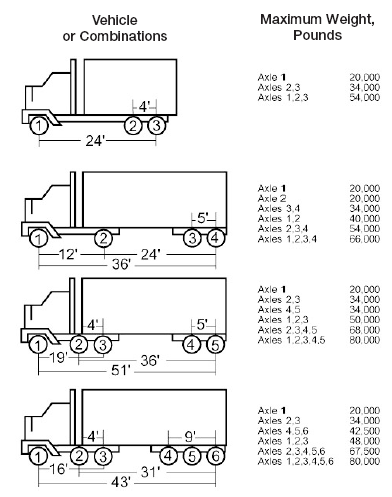Axle Weight Limits by State
Steer, Drive, Single, Tandem, Tridem Axle Load Legal And Permitted Weight
Introduction
Every open road in the US is regulated by constraints in regards to oversize/overweight commercial trucks both by federal and state laws, even down to municipal in some cases. These regulations and their ramifications dictate the global market. Manufacturing firms have to consider the size of their products to reduce overhead cost of shipping. Worldwide exporters must also keep a close eye on these regulations while transporting over international waters and borders. With all of this in mind, the government calculates the road and infrastructure damage by creating overweight permits. Officials have taken years to create a consensus from their data in order to build these regulations that govern the roadways and the law enforcement doesn’t take it lightly if the laws are broken.
Principal Concerns
Several factors are taken into consideration before ever loading up a trailer. Such factors include the following: load dimensions (length, width, height, weight), if the trailer and truck pulling it is rated to handle such dimensions, if the dimensions are in compliance with the regulations, etc.
Axle and Equipment Regulations
Why are these regulations necessary to begin with? A look at the most basic algebra answers that question. Pressure is equal to force divided by area (P=F/A). Simply put: the more area that is there to spread the force out, the less severe the force becomes. In the illustration below, notice that the more axles and space added (more area) the more load weight (more force) is allowed on the truck and trailer.

Federal Regulations
The following are the Federally mandated maximum weights for the National System of Interstate and Defense Highways and reasonable access thereto (23 CFR Part 658.17):
- 80,000 pounds gross vehicle weight
- 20,000 pound single axle weight
- 34,000 pound tandem axle weight
Axle spacing is another consideration that must be taken into account when looking at Federal weight compliance. To protect bridges, the number and spacing of axles carrying the vehicle load must be calculated. Thus, a bridge weight formula is also applied to commercial vehicles in determining their compliance with Federal weight limits. The Federal bridge formula applies when the gross weight on two or more consecutive axles exceeds the limitations of the formula, except that two consecutive sets of tandem axles may carry a gross load of 34,000 pounds each if the overall distance between the first and last axle is 36 feet or more.
W=500(LN/N-1 + 12N + 36); where W=overall gross weight on any group of 2 or more consecutive axles to the nearest 500 pounds. L=distance in feet between the extreme of any group of 2 or more consecutive axles, and N=number of axles in the group under consideration
Bridge Formula Weights – all loads traveling on the interstate roadways must comply with the Federal Bridge Formula.
Information pulled from the FHWA.DOT.gov website.
Below is a list of states and their axle weight limits
Click on the states below for links to the state's guidelines for for axle weight limits for commercial vehicles / heavy haul shipping. These regulations are subject to change for each state. If something doesn't look correct, give us a shout and let us know so we can property update the page.
UNITED STATES OF AMERICA
Massachusetts
New Hampshire
North Carolina
South Carolina
West Virginia
CANADA



